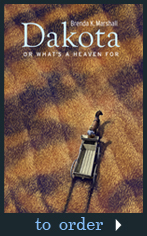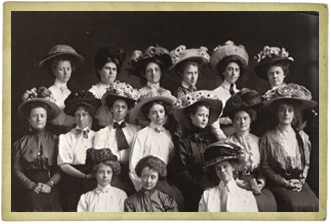Dakota, Or What’s a Heaven For: Inspiration
For more on Inspiration please visit my blog for ‘Books That Matter’ ![]() .
.
I suspect that most writers, when asked how a book “came to be,” necessarily fabricate another fiction. There is no tidy narrative that can accurately sum up the process of writing. There is no clearly defined beginning, no absolute end.
Although I did not know it at the time, I began to “write” Dakota, Or What’s a Heaven For one day in 1995 while on vacation at Pawley’s Island in South Carolina, where my partner and I were celebrating the acceptance for publication of my first novel, Mavis. Browsing through postcards in a tourist shop I came upon a photograph of sixteen young women dressed in their late-nineteenth-century best. I was arrested by the intelligence of the eyes of one of the women, and the ghost of a smile that seemed to me to have nothing at all to do with humor. Exploring the meaning behind that smile, I wrote a short story that weekend about that young woman.
Putting aside (or so I thought) that short story, I began another novel, one that was to be set in Dakota Territory in the late-nineteenth century. But it wouldn’t take hold. I had the place, the time, the conflicts and themes in mind, but my characters refused to come alive. Another story intervened, one with characters that mattered to me, and for the next five years I worked on that novel. Then, in 2001, I decided to return to my Dakota Territory story. This time, the main character was waiting for me. She was Frances Houghton Bingham, demanding to step out of the postcard and beyond the short story and into a sprawling tale of desire, ambition, and transformation.
So, did I begin Dakota that day in 1995 in South Carolina? Or on the hammock with my laptop one summer afternoon in 2001 in Michigan? Was I writing the novel as I read histories of Dakota Territory, diaries and memoirs of homesteaders and bonanza farmers, the letterpress correspondence of a Northern Pacific Railroad employee, nineteenth-century periodicals, or the microfilmed pages of Dakota Territory newspapers? (See bibliography)
Was I writing as I studied photographs of bonanza farm fields, of school children in front of country schoolhouses, of immigrants laying train tracks across the prairie or across the frozen Missouri River, or of a settlement once called Centralia that yearly grew from a ramshackle assortment of shacks and tents into the neat blocks of Fargo? Was I writing as I ran a gloved hand (under the careful observation of a museum curator) over corsets and jackets and shoes worn by women and men of another century, or when I walked through the spacious hallways of a mansion in St. Paul that was once the home of a railroad magnate, or when I stooped in a sod hut still standing in the midst of a modern farm’s outbuildings, or knelt next to a grave, inscribed in Hebrew, in a tiny cemetery surrounded, to this day, by prairie grass? Was I writing as I limited my leisure reading, for two solid years, to nineteenth-century British and American fiction, attuning my ear to the cadences of another century? In other words, is a writer who reads, listens, touches and imagines, writing? I think so. But it isn’t neat and it isn’t precisely causal.
And the end? When is a writer done? Once, I would have said that I “finished” Dakota, Or What’s a Heaven For in the summer of 2006. Responses by several readers—trusted friends, my agent, editors—helped me to see the novel again, and again, for that is what is meant by re-vision. Thus, in my mind, Dakota stretches and shrinks. Behind certain chapters there are stories, phantoms, ghosts, and more histories. You cannot see them, but I do not think that the novel could have existed without them. (For some samples of the novel as it exists in present time, please visit excerpts and videos.)
More importantly, the novel is never finished because you, the reader, will now take over. No one of you will read the same book. You will bring your own memories, and expectations, and experiences with you as you read, and the result will be a world newly imagined. This is the gift that the reader brings to the novel and to the author.
If you would like to share your experiences and reflections as a reader of Dakota, please submit your thoughts.



